FITOU, by the sea
Fitou is at the eastern edge of the Corbieres, by the étang of Leucate; the region is known as Corbieres Maritime.
I believe this is the place where Mary Magdalene and Jesus landed after they left the Holy Land, in 33AD, six weeks after the crucifixion, that Jesus survived, arriving in France in June 33AD.
Fitou village consists of two villages, Fitou, a little inland in a cleft in the mountains, and Cabanes de Fitou, which is on the main A9 that runs parallel to the coast. Cabanes de Fitou is the part whch interests us the most.
 A mystic harbour?
A mystic harbour?
In Roman days Cabanes de Fitou was a stoppover serving travellers on the Via Domitia, the Roman trunk road from Nimes to Spain, approximately where the N9 is today. Cabanes de Fitou was known as Ad Vigesinium, or sometimes Ad Vicentinium, for a long time.
My "Carte Archeologique de France," tells us that Ad Vigesinium existed from 50BC to the 4th century, attached to the Via Domitia. The cluster of houses known as Estacades is the most important, dating from the Republic (before 26BC). Numerous remains were found on this parcel of land; roof-tiles, pottery, amphores, construction blocks, a grave "of incineration" made of tiles, and other sepulchres and grave furniture. Near the well was a treasure; coins from Nîmes to the north and Ampurias to the south, a penny of Caesar, a bronze coin of Antonin and a gold coin from the time of Nero.
Ad Vigesinium was only a few metres from the coast. However, situated on today’s inland étang of Leucate, people coming by sea could not have landed there, could they, because the étang is an inland lake?
Not 2000 years ago it wasn’t! I have long thought the coastline was different 2000 years ago and the official web-site for Fitou confirmed it; vestiges have been found proving the étang was once the seaside. I found a map showing how the étang was 2000 years ago. The two étangs of today, the one near Narbonne called the étang of Bages and Sigean, and the étang of Leucate, were all one and were open sea, with islands in it; the level of water was higher then.
The spur of land close to "Ad Vigesinium", now known as Les Sidrières, existed in those times as an island.
So; was there a port or harbour by Fitou and if so, where was it? (Take no notice of “Port Fitou” marked on the map; it is merely a holiday village.)
My guide book to the Corbieres, by Abbe Giry, tell us; "The north-east part of the plain of Fitou, next to "Estagniols," served as a port to little flat-bottomed boats carrying country produce to the great boats anchored in the sea." This locates a shallow-water port or harbour on the coast a little to the north of Cabanes de Fitou.
I went with fellow researcher Jaap Rameijer to investigate, on a gloomy, cloudy day. Indeed there is a small harbour and a cluster of houses around it on the island of Sidirères. Not a soul was about. If the sea was stormy, this place, on the Isthmus of the spur of land, would have been sheltered, and the nearest place to Ad Vigesinium. You can find it for yourself; turn off the main road just north of the old Cave Co-operative, and you will see a narrow road going under the railway line through an even narrower bridge! The port/harbour/hamlet is about 200 metres further.
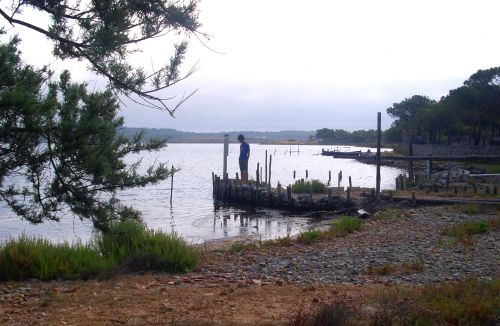
Because the actual shoreline was a little higher up 2000 years ago, so one cannot pin-point a landing spot with any accuracy but one can sense what a lovely place it is. But we weren’t sure; we got bad vibes because the weather was so bad that day and the mud-flies rose in clouds as we walked along.
We left the harbour and drove a few hundred metres northwards, on the fisherman's track to a lovely wide beach, with an island opposite it covered in birds, and this too was attractive, peaceful and beautiful. These beaches are also more sheltered now than they were then, by the sand-bar on which are today's holiday resorts of Leucate. Both the harbour and the beach could have been the small port mentioned in Abbé Giry’s book.
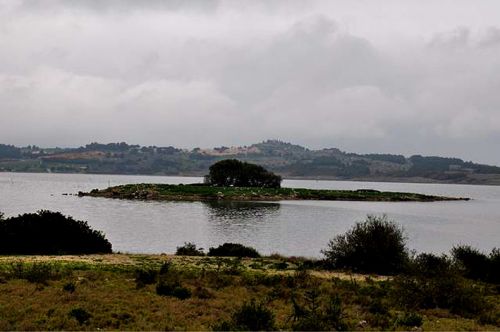
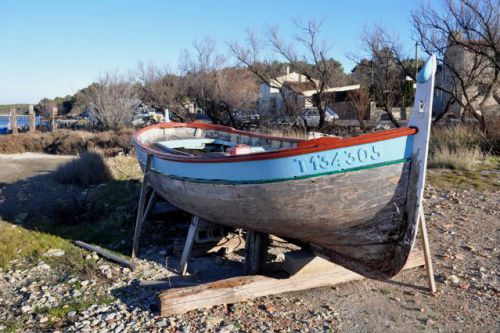
Both the harbour and the beach are within 500 metres of the Roman mansio, or stopping over place, now called Cabanes de Fitou, on the Via Domitia, the great Italy/Spain road that skirted the French Mediterranean coast in Roman times. People arriving by sea at Fitou, perhaps with one or two servants, would have been able to buy supplies and donkeys or horses at the mansio.
I think that is what Mary and Jesus did. They would not want to linger long. Jesus had fled Herod and the Pharisees as well as the Romans back in the Holy Land. My feeling is they sent their servants to deal with things as rapidly as possible, then quietly slipped away, up the hill to today's Fitou, then over the hill, on a minor Roman road. Freedom!
Magdalene Hill
But there was more to explore! It is a hill called “La Madeleine.” This name was quoted by several books about Rennes-le-Château and its mysteries as the place where Mary Magdalene and Jesus landed in the south of France - and this was the only place with that name all the way along the Mediterranean coast from Spain to Italy.
We found La Madeleine, a minor road goes past the foot of it, and there's room to park just before the bridge over the motorway. A footpath goes up - people walk this hill in the summer. Everywhere is stony and covered with dry-stone walls and shepherd's capitelles. Between the stones grow herbs, thyme and fennel, then yellow broom and fly orchids.
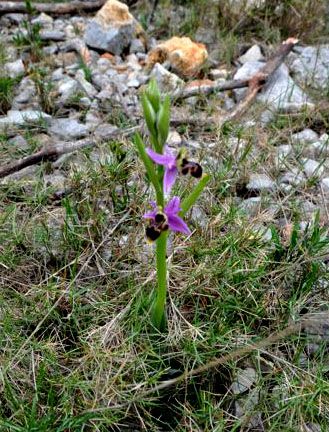
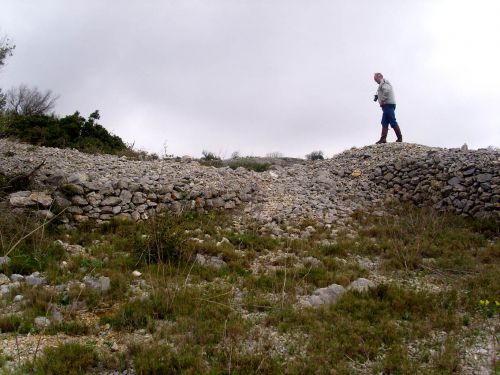
Could Mary Magdalene have lived there? I didn't think so, but Jaap did, certainly the stones would have made constructing a house or shelter very easy. He thought Mary and Jesus could actually have lived on this hill, but I felt they left for their destination right away.
The view from La Madeleine is marvellous, you can see the étang and Les Sidrieres - and then imagine, as I did, Mary and Jesus passing through Ad Vigesinium, perhaps picking up supplies, and then setting out on their journey to Rennes-les-Bains.

When we came down the path off the Magdalene Hill that day, we saw a Judas tree in full bloom. These trees flower every Easter, it's said, in memory of the Crucifixion.
I was fascinated by La Madeleine, but couldn't find any confirmation of origins.
Then by sheer chance, I was reading a French book about ancient routes in the south of France. A paragraph said; "A little before Cabanes-de-Fitou, the place called La Madeleine perpetuated a medieval hospice. Further on, the N9 and the Via Domitia, now the same road, reaches the pass of Malpas." (I include this last sentence because it exactly defines the location.)
The word hospice means home or monastery - this was a place of rest for ill people who needed caring and it was dedicated to Mary Magdalene. I found the idea interesting that Mary Magdalene was associated with healing; there is no mention of her healing in the Bible, only a hint that she was among the women who baptised when they accompanied Jesus and the disciples.
There is a strong connection between Mary Magdalene and Fitou. But where on the Madeleine hill was the exact place where she lived, or where the hospital was?
The following spring I returned with my friend Olivier and his sons Thomas and Julien. We parked by the motorway and walked up the track. Julien had been reading books about knights and castles of the Middle Ages. He saw a stone hut on the left of the track and said it had once been a well. Indeed, it looked like a something built to shelter a well.
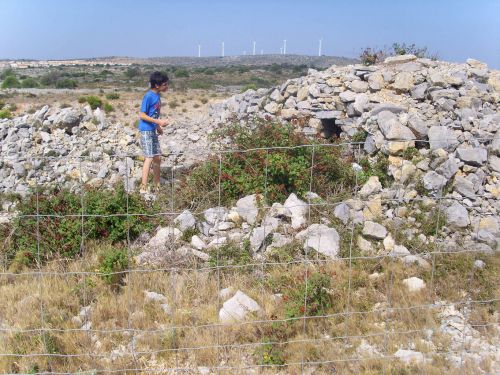

A bit further on, on the right, were stone walls, crumbled but one inside the other, that he declared were ramparts. Indeed they looked like them. As this was the highest point of the hill, we thought it likely that the hospice named after Mary Magdalene was there.
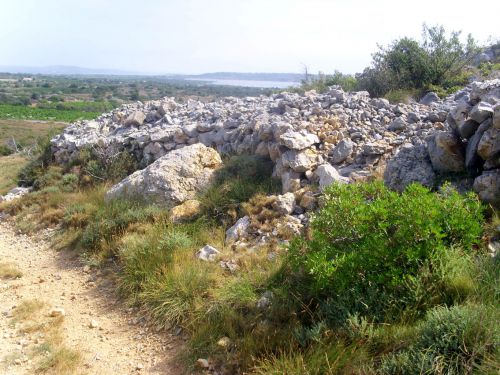
In those days the disease of leprosy was widespread and people were isolated in hospitals. Except that it wasn’t really leprosy but what is called today psoriasis. The baths at Rennes-les-Bains were called Lepers’ baths but they were for people who had psoriasis; thermal waters will cure this but they don’t cure leprosy. Maybe it was believed at Fitou that the fresh air off the sea was beneficial for invalids.
Later I looked at the Google map and it seemed to me that these ramparts indeed enclosed a circular space which could have been the ancient hospice.
Named after Mary Magdalene.
This was just the start of an incredible journey. To find out more, click here.
Inscrivez-vous au site
Soyez prévenu par email des prochaines mises à jour
Rejoignez les 261 autres membres

